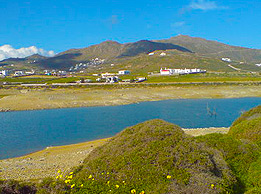Mykonos Activities

Behind the cosmopolitan glitz the photos, the wild parties the shopping, the resorts, the bars and the restaurants lies another Mykonos, an island of incredible natural beauty, full of unknown coves, and well hidden secrets. It's in the face of the island locals and loyal friends love. It's the real Mykonos.
Museums
Archaeological Museum of Mykonos
Open daily from 08.30 to 03.00,
except Mondays and public holidays
Tel : +30 22890 22325
The building was built in 1902 in Kamnaki to house the finds from Vothrs tis Katharseos, a 5th century BC tomb in Renea island (the so called by locals Megali Delos(), that was uncovered in 1898. the museum now houses a rich collection of pottery, representative works from the 6th century BC, sculptures and other art facts.
Back to top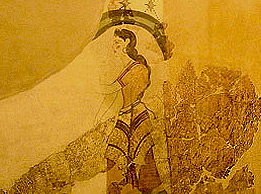
Naval Museum of the Aegean
Open daily from 10.30 to 13.00 and from 18.00 to 21.00 (Apr-Oct)
Tel : +30 22890 22700
In Tria Pigadia, it features replicas of the rowboats, sailboats and steamboats that have sailed the Aegean through the millennia. There is also a rich collection of maps and engravings, ancient coins and weights. The house was formerly owned by Mykonian captain Soumelis. The museum was founded in 1985 by G.M. Drakopoylos.
Back to top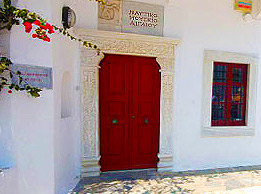
Folklore Museum
Open daily from 16.30 to 20.30 except Sundays (Apr-Oct)
Tel : +30 22890 22591/22748
In an old two-storey mansion, with six halls featuring collections of old furniture, ceramics, Byzantine icons, needle works and textiles. Notice the nice collection of shop models.
Back to top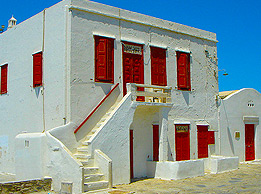
Agrotomouseio
Open daily from 10.30 to 13.00 and from 18/30 to 21.00 (Apr-Oct)
Agrotomouseio is in Ano Myloi, an open-air museum aht showcases the traditional agricultural installations used in Mykonos for the production of agricultural products (the furnace, the wells, the threshing floor, the wine press), including the fully-operating Bonis Mills (Mylos tou Boni). From July to September visit daily from 16.00 to 20.00.
Back to topLenas House - Folk Museum
Tel : +30 22890 2239
To Spiti Tis Lenas, which is close to Tria Pigadia and us practically a typical 19th century Myconian house wit its complete facilities and furnishings.
Back to top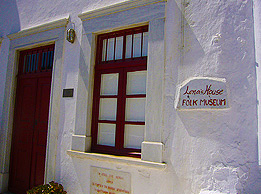
Municipal Library
Municipal Library of Hors, which contains 4.000 titles as well as historic and photographic archives.
Back to top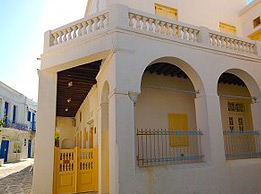
Architecture
Here the cubist, white architecture can be seen nearly at its best (it is better only in such remote islands as Folegandros and Sifnos). There is a good deal of variety in the size and shapes of houses, but color is not admitted except the doors or shutters or the pink, green or blue domes or roofs of some of the countless little churches (one is told there are 365, but that need no to be taken as an accurate estimate. The architectural gem in the Paraportiani, four chapels on different levels forming one church on the site of old fortress.
The Athens School of Fine Arts used to enjoy a suburb view from the town's highest point. Pink oleanders, and scarlet hibiscus, and trailing green pepper trees also from a contrast amid the dazzling whiteness-kept up by frequent renewal of the whitewash. Today one can see that the hotels of Mykonos, from the small family hotels to the modern complexes, accord to the island's traditional architecture.
Mykonian Houses are cubic in shape, with one or two floors, small balconies (boundia) of wood, stone or iron, high chimneys (kapasi) courtyards and eaves troughs (kanali).
Back to top
Cuisine of Mykonos
You will find an opportunity on Mykonos to try the island's tasty traditional dishes. Try syglino (chunks of salt pork), louses (smoked pork), delicious pies and savory kopanisti cheese. Classical Mykonian sweets include amygdalota (marzipan) and diples (fried bow knots). We have listed some of the best restaurants and tavernas of the island of Mykonos... but till you get there to savor the delicious dishes of Greek cuisine, we will provide you with some traditional Mykonian recipes.
Back to top
Marzipan
Ingredients
- 205gr blanched almonds
- 3-4 egg whites
- 350gr sugar
- A little vanilla or rosewater
- 20 blanched almond halves
Grind up the almonds in a fine mill together with the sugar, the three egg whites and the vanilla until a soft dough is created. Butter a piece of wax paper wll, and place on a cookie sheet. Place spoonfuls of the mixture on the sheet in the shape of a small pear and put one of the almond halves in the centre. Bake the marzipans at 200_C, until they have turned golden brown. Let them stand for a while, remove carfully and allow to cool. Keep the marzipans in a well closed container so that they do not dry out.
Syglino
Ingredients
- Pork meat
- Sage, rosemary, thyme, oregano
- Branches of prickly oak
Cut the meat into slices. Hang the slices of the pork about 1-1.5 meters from the ground. Under the hanging meat slices light a fire with the herbs and oak branches, being careful not to create a flame, just smoke. The smoking of the meat should last as long as possible (23hours). When the smoking is finishes, wash the meat and place it in a pan with some water and salt to boil. After it is cooked, place the contents of the saucepan in a clay pot, allow it to cool, and your syglino is ready. Served both as an appetizer and as a main dish.
Back to topOnion Pie
Ingredients
- 2kg onion
- 4 eggs (crushed)
- 500gr feta cheese
- 1 small cup of kefalotyri or parmesan cheese
- 1kg tomatoes
- 1 small cup sultana raisins
- 400gr olive oil
- 250gr fine tapioca
- Salt & pepper
For the phyllo dough
- 750gr flour
- 205gr olive oil
- 1 level teaspoon salt
Peel and slice the onion thinly into a bowl. Add the oil, salt, pepper and mix well. Add the tapioca and mix well. Put in the grated cheese, feta in small chunks, raisins and beaten eggs. For the Phyllo: Place the flour and oil into a bowl and mix with a littlw water until a fairly stiff dough is formed. Divide it into 8 pieces, which you will form into balls and leave covered on the marble counter for 15 to 20 minutes. Roll out the dough into very thin sheets. Place three sheets in a large oiled pan, brushing each one with oil. Then spread the filing evenly over them. Place on the remaining sheets, oiling each one. Cut the top crust twice to make three equal length wise parts. Sprinkle with a little water and bake at 200_C fro 75 minutes.
Savory vegetable pie
Ingredients
- 500gr Chervil and sweet cicely or other aromatic herbs
- 500gr Spinach
- 250gr Green onions
- 250gr Mykonos kopanisti cheese dill, parsley
- 300gr Olive oils
- 1 small cup of sweet trahanas
For the phyllo dough
- 4 small cups flour
- 1 small cup olive oil
- 1 small cup water
- Half a lemon
- 1/2 tsp grated lemon rind
- Pinch of salt
Chop herbs, spinach and onions finely. Rub well with a little salt and press to remove excess moisture. Fry the onions in the oil and then add the vegetables, pepper salt, kopanisti, syglino and trahanas. Mix well and set aside. Meantime, make the dough. Mix together all the ingredients and kneed long enough to make the dough, which is larger than the others. Place the larger one first in an oiled banking pan, brush with oil, then add the second sheet. Spread the filling over the two sheets of dough and cover with the other two sheets. Brush the top sheet with oil, cut it lightly twice, lengthwise and bake in a moderate oven for 75 minutes.
Back to topLocal Products
Kopanisti
A type of soft cheese with a peppery, spicy flavor. It is usually made of cow milk, or a mixture of cow, lamb and goat milk. It is then congealed and drained in the traditional manner. It takes several months for its maturation. During that time more cheese is always added to the mixture for the fermentation to continue. If you go to Mykonos, you definitely have to taste it-since it is the product most closely connected to the island.
Back to topKsinotyri
Same thing as sour skim-milk cheese, but left for several weeks to mature, and become really dry. Mykonians grind it over their meals.
Back to topLuntza
It is made of the same part of the pig that gives is the fillet. You can find it in other islands also, though slightly different. Mykonians put the fillet in salt for about 24 hours, after it has been cured with spices, oregano, peppers and savory large quantities. Then it is stuffed in "eyes" (the pig's lower intestine) and hanged to "dry" in the air. Before that they light up a fire made of pig manure, while repels flies. After two weeks, the louza is already to be consumes. The intestines are removes and it is cut in small slices.
*In northern Italy is called Lonza and in Cyprus louzja
Back to topSausages
Mykonos' sausages are considered the finest in Greece, as they have a large content of meat, and a significantly smaller amount of fat. They are produced in a way similar to that of the loujza.
Back to topOpen air market
Open air markets, the so called laiki in Greek take place in every neighborhood all around Greece. But in Mykonos the laiki is closely connected to tradition, like time has never touched this habit of Myconians... Every morning from 7.30 am to 1.30 pm (unless it is too windy) a farmer's market is held in Yalos. Friendly donkeys woth heavily loaded panniers (also three-wheelers or pickup trucks) bring in produce of every kind, both local and imported.
Back to topFestivals
Festivals are organized many times each year with folk music and bands, dancing and plenty of wine. The most important of these are the Panagia Toutliani church, on 15th August, and the fishermen's festival, on 29th June and 6th December. On the second Sunday of September, the grape harvest festival is held, in Hora, at the open air Agrotomouseio-Mykos Boni. It is also worth observing the "Hirosfagia" (pig slaughtering) that take place in October and lasts days.
Back to top
Churches and Monasteries
Monastery of Panagia Tourliani
Visit the monastery of Tourlianis for the great fest of August 15th. The monastery is practically at the centre of the village, and was founded in 1542 by the two monks Paros Katapoliani where an older church used to be. In 1767 it was renovated and became what it is today. Its architecture, especially the bell-tower, is impressive. Thre is also a cure marble fontain at the front.
Back to top
Monastery of Palaiokastro
At the north part of Ano Mera you will find the monastery of Palaiokastro, now in ruins, that used to look like a front, with a wall surrounding it.
Back to topAgios Panteleimon
Agios Panteleimon in Marathi, considered the third most significant monastery on the island. It was founded in 1665 by monks Kampourakis and Gerasimos. The paved floor was added in 1820.
Back to topAghios Nikolaos toui Gialou or tis Kadenas
It is right across the City Hall, and was renovated by the Russian Consul of Mykonos, count Ioannis Voinivic. It got its final appearance in 1912 - notice the impressive blue dome.
Panagia Theotokos I Pigadiotisa
The poshet church on the islands, with gorgeous icons and a sparkling interior. It is the orthodox Metropolis of the island.
Back to topAgia Eleni tou Kastrou
A large basilica with great woodcut icon screen and Byzantine icons of the 17th and 18th century.
Back to topAgia Sotiria
A small church right by the sea by the sea. Under its floor lies the grave of the last pirate, Manolis Mermelechas, who died in 1854.
Back to topLady Paraportiani
One of the most photographed churches of the world. Located in the Kastro quarter at the edge of the port, and regarded as the jewel of Mykonos. The church dates to the Byzantine era and is distinguished by its exceptional form, its asymmetrical masses and low, stepped bell tower. One of the finest examples of Cycladic vernacular architecture.
The name Paraportiani is derived from the word paraporti ("little door" in the Mykonisn dialect), because it was built beside the gate of the medieval castle.
Back to top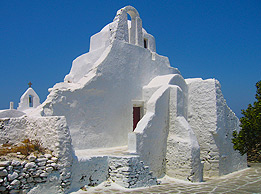
Open Air Cinema Mando
One of the loveliest summer cinemas in Greece, in a beautiful garden setting (Meletopoulou Gardens).The season begins in June, and the program changes three times a week. A printed program for the entire season is available. Open air cinemas - for those who do not know about them - can be found everywhere in Greece even in the big cities next to the new high tech complexes.
Thought the seats are not always comfortable and the lightning, in case the sun has not fully set by the time the movie starts, is not the best, the open-air cinemas offer a unique experience and this is why Greeks prefer them. Usually the open air cinemas are gardens with loose stones on the ground and trees and flowers around them. Between the chairs you will find tables where you can put the refreshment and pop corn you have bought during the break from the canteen. Cine Mado is one of the best of its categories cinemas and it is worth visiting!
Information at Tel. : +30 22890 27190-1
Back to top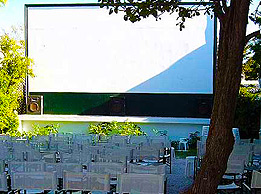
Aquatic Habitats
The costal "aquatic habitat" of Panormos and Ftelia, with a variety of flora and fauna, frequently become transformed into little lagoons, significant stopover points for migratory birds.
In number of regions, such a Marathi, currents and basins are created for the outflow of water, leading finally to the creation of an aquatic habitat, such as in Ano Mera. Unfortunately, two other equally important aquatic habitats in the region of the Empourdechtis and the Ornos have been gradually degraded.
Back to top